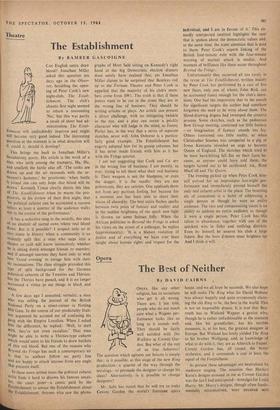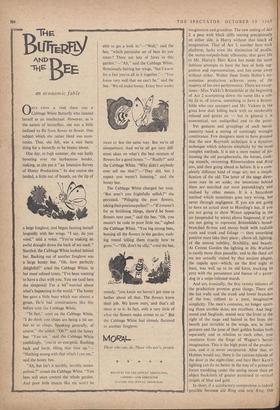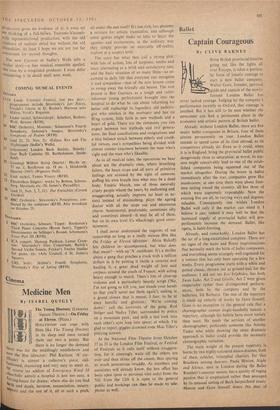Opera
The Best of Neither
By DAVID CAIRNS
Mr. Solti has stated that he will try to make Covent Garden the world's foremost opera
house, and we all hope he succeeds. We also hope he will make The Ring what Sir David Webster was always happily and quite erroneously claim- ing the old Ring to be, the best in the world. This is not an impossible dream. It is true that Bay- reuth has in Wieland Wagner a genius who, though he is rather unfashionable at the moment and, like his grandfather, has his terrible moments, is, at his best, the greatest designer in Europe. But Wieland has lately yielded The Ring to his brother Wolfgang; and, in knowledge of what to do with it, they are as Alberich to Fajner. Covent Garden has, all round, the better orchestra; and it commands a cast at least the equal of the Festpielhaus.
At present these advantages are neutralised by mediocre staging. The emotion that Herbert Kern's designs aroused in me at Covent Garden was the last I had anticipated—nostalgia for Leslie Hurry. Mr. Hurry's designs, though often funda- mentally misconceived, were streaked with imagination and grandeur. The new setting of Act 2, a pass with black cliffs rearing precipitously on either side, is Hurry without that touch of imagination. That of Act 3, another bare rock platform, lacks even the distinction of profile, the motor-torpedo-boat silhouette, that gave life to Mr. Hurry's. Herr Kern has made the same dubious attempts to have the best of both sug- gestion and representation, and has come away without either. Within these limits Holler's no- nonsense production achieves some of the majesty of his own performance. There are excep- tions—Miss Valkki's Briinnhilde at the beginning of Act 2 scampering down the ramp like a rab- bit (it is, of course, something to have a Brtinn- hilde who can scamper) and Mr. Vickers in the great love duet lolling back with an intolerably relaxed and genial air — but in general it is economical, not undignified and to the point.
Yet gestures and groupings of such heroic austerity need a setting of cunningly wrought contrivance. Few designers seem to have grasped that the new Bayreuth technique is a dynamic technique which achieves simplicity by the most complex methods. It is not a mere matter of jet- tisoning the old paraphernalia, the horses, cook- ing utensils, swimming Rhinemaidens and Ring zoo, and then going ahead as before. It is a com- pletely different kind of stage art, not a simpli- fication of the old. The letter of the stage direc- tions may be set aside; the intentions behind them are searched out most painstakingly and realised by other means. It is a hazardous method which sometimes goes very wrong, but never through negligence. If you are not going to have an actual door to Hunding's hut, if you are not going to show Wotan appearing in the air (suspended by wires) above Siegmund, if you are not going to represent BrOnnhilde's broad- branched fir-tree and mossy bank with realistic roots and trunk and foliage — then something positive must take their place; above all, lighting, of the utmost subtlety, flexibility, and beauty. At Covent Garden the lighting in Die Walkiire is rarely more than passable; and in the third act we are actually visited by that ancient plague, the cupola spot—which, on the first night at least, was well up to its old form, tracking its prey with the persistence and finesse of a game- dog in a snipe-infested marsh.
And yet, ironically, the first twenty minutes of the production promise great things. There are the but walls and the trunk and lower branches of the tree, refined to a pure, imaginative simplicity. The men's costumes, no longer sport- ing those terrible. skins, are excellent. And Sieg- mund and Sieglinde, seated near the front at the right of the stage and haloed in fire from the hearth just invisible in the wings, are, in their gestures and the pose of their golden bodies both separately and in relation to each other, true creatures from the forge of Wagner's heroic imagination. This is the high point of the produc- tion, and it is never recaptured. After that, as Holmes would say, there is the curious episode of the door in the night-time; and here Herr Kern's lighting can do no better in the way of a primeval forest trembling under the spring moon than an abject backcloth of gauzes patterned in vertical stripes of blue and gold.
In short, if a satisfactory compromise is indeed possible between old Ring and new Ring, this Production gives no evidence of it; it even set The thinking of a full-blOwn, Teutonic-Visconti- Style representational production, with the old °PUlence of realistic detail but without the old absurdities. At least I hope we are not too far committed for second thoughts.
The new. Carmen at Sadler's Wells tells a similar story—a fine musical ensemble spoiled, this time by a misguided producer. I must defer considering it in detail until next week.








































 Previous page
Previous page